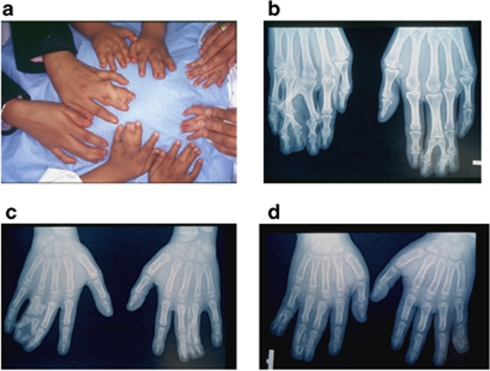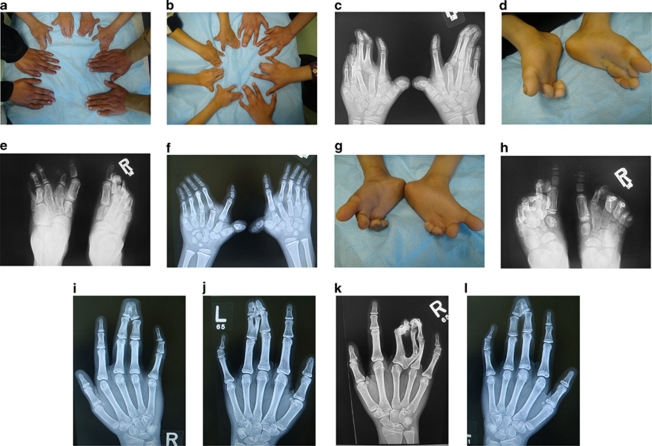Abstract
Type II familial synpolydactyly is rare and is known to have variable expression. However, no previous papers have attempted to review these variations. The aim of this paper was to review these variations and show several of these variable expressions in two families. The classic features of type II familial synpolydactyly are bilateral synpolydactyly of the third web spaces of the hands and bilateral synpolydactyly of the fourth web spaces of the feet. Several members of the two families reported in this paper showed the following variations: the third web spaces of the hands showing syndactyly without the polydactyly, normal feet, concurrent polydactyly of the little finger, concurrent clinodactyly of the little finger and the ‘homozygous' phenotype. It was concluded that variable expressions of type II familial synpolydactyly are common and awareness of such variations is important to clinicians.
Keywords: type II familial syndactyly, inherited synpolydactyly, variations of expression
Introduction
Type II familial synpolydactyly is rare and it has been reported in <30 families.1, 2, 3, 4, 5, 6, 7, 8, 9, 10, 11, 12 It is characterized by bilateral synpolydactyly of the third web spaces of the hands and bilateral synpolydactyly of the fourth web spaces of the feet. It is inherited as autosomal dominant and the mutation has been localized to 2q31 (HOXD13).5, 6, 7 In this paper, we report on two families with an emphasis on variations of expression of this rare form of inherited nonsyndromal syndactyly. These variations have not been previously reviewed in the literature.
Case reports
The first family
The family had a history of synpolydactyly type II for several generations on the mother's side (Table 1). The mother and her three children were affected and were examined (Figure 1). The feet were normal in all affected members. One child showed a variation in the form of synpolydactyly of the little finger, which was an isolated finding in the left hand and was concurrent with synpolydactyly of the third web in the right hand.
Table 1. Summary of the variations in the two families reported.
| Family | Parents | Children | Variations |
|---|---|---|---|
| I | Normal father, affected mother (unrelated parents) | All three children were affected | In one child: right hand, synpolydactyly of third web and synpolydactyly of the little finger; left hand, isolated synpolydactyly of the little finger |
| II | Both parents had little finger clinodactyly (first-degree cousins) | Four out of six children were affected | The two boys: Severe bilateral hand brachydactyly with hypoplasia of the middle phalanges The ulnar two metacarpals lost their normal tubular shape and appear polygonal Bilateral accessory carpal bones and bilateral thumb clinodactyly There was bilateral feet involvement with brachydactyly and hypoplasia of the middle phalanges Several metatarsals lost their normal tubular shape and appear polygonal Tarsometatarsal fusion |
| The two girls: One hand showed the classic synpolydactyly of the third web whereas the other hand showed the syndactyly without the polydactyly There was also bilateral concurrent clinodactyly of the little fingers (trapezoid middle phalanges) The feet were normal |
Figure 1.
The first family: (a) the mother (3 o'clock position) and her three affected children. The child of interest is at 12 o'clock position. (b) X-ray of the mother showing the classic features. (c) X-ray of the child at 6 o'clock position showing the classic features. (d) X-ray of the child at 12 o'clock position showing the variations listed in Table 1.
The second family
The parents in this family were first-degree cousins and the family had a history of synpolydactyly type II for several generations. Both parents had isolated clinodactyly of the little finger. They had a total of six children, of which four were affected. The two boys had similar features in the hands with feet involvement whereas the two girls had similar features in the hands with no feet involvement as shown in Table 1 and Figure 2.
Figure 2.
The second family: (a) the two parents with the two affected boys to demonstrate the clinodactyly of the little finger in the parents. (b) The four affected children. The two boys are at 8 and 10 o'clock positions whereas the two girls are at 2 and 4 o'clock positions. (c–e) X-rays of hands and clinical/radiological appearance of the feet of the boy at 8 o'clock position. (f–h) X-rays of the hands and clinical/radiological appearance of the feet of the boy at 10 o'clock position. (i and j) X-rays of the hands of the girl at 2 o'clock position. (k and l) X-rays of the hands of the girl at 4 o'clock position.
Discussion
The classic features of type II synpolydactyly include bilateral synpolydactyly of the third web spaces of the hands and bilateral synpolydactyly of the fourth web spaces of the feet. Our cases are not only rare but they also show several variations of this form of syndactyly. We have reviewed the literature and tabulated these variations (Table 2).
Table 2. Reported variations of type II familial synpolydactyly in the literature.
| Authors | Variations |
|---|---|
| Cross et al3 | Some hands show the third web syndactyly without any polydactyly, and the feet may be normal |
| Camera et al2 | Aplasia/hypoplasia of middle phalanges of the toes |
| Merlob and Grunebaum6 | Metacarpal/metatarsal abnormalities such as ‘widening', ‘narrowing' or ‘Y-shaped' |
| Sayli et al10 | Simultaneous pre- and postaxial polydactyly, concurrent postaxial polydactyly type A, bilateral little finger clinodactyly, hypoplasia of the middle phalanges |
| Temtamy and McKusick11 | Concurrent clinodactyly of the little fingers |
| Kjaer et al5; De Smet4 | Concurrent clinodactyly of the little finger. Some family members show isolated clinodactyly indicating that the gene may be expressed as an isolated clinodactyly |
| Ridler et al8 | Some family members show isolated little finger minor abnormalities such as camptodactyly, hypoplasia/aplasia of the distal phalanx. Distortion of dermatoglyphic patterns may be seen in severe cases |
| Akarsu et al1 (homozygous phenotype) | Synpolydactyly may involve all digits, short hands and feet, some of the metatarsals/metacarpals lose their normal tubular shape and appear polygonal, tarsometatarsal fusions, phalangeal synostosis |
| Muragaki et al7 (homozygous phenotype) | Syndactyly includes the third and fourth web spaces, severe brachydactyly, affecting all digits, some of the metatarsals/metacarpals lose their normal tubular shape and appear very short and frequently there are accessory carpal bones |
In 1968, Cross et al3 reviewed the world literature (there were only 14 reported families in 1968) and stressed on the fact that some hands may show the third web space syndactyly without any polydactyly and that the feet may be normal. These two features were seen in the two affected girls of the second family. Sayli et al10 showed that some family members may show polydactyly of the little finger and this was seen in one child of the first family. Several authors5, 11, 12 showed that clinodactyly of the little finger may be a concurrent or isolated feature, indicating that the responsible gene may be expressed as an isolated clinodactyly and this was seen in the parents of the second family. Finally, Akarsu et al1 and Muragaki et al7 have described the ‘homozygous' phenotype that is characterized by short hands, polygonal metacarpals/metatarsals, accessory carpal bones and tarsometatarsal fusion. These findings were seen in the two affected boys of the second family.
In conclusion, variations of type II familial synpolydactyly are common and our report summarizes these variations from the literature and shows them in two families.
The author declares no conflict of interest.
References
- Akarsu AN, Akhan O, Sayli BS, Sayli U, Baskaya G, Sarfarazi M. A large Turkish kindred with syndactyly type II (synpolydactyly). 2. Homozygous phenotype. J Med Genet. 1995;32:435–441. doi: 10.1136/jmg.32.6.435. [DOI] [PMC free article] [PubMed] [Google Scholar]
- Camera G, Camera A, Pozzolo S, Costa M, Montero R. Synpolydactyly (type II syndactyly) with aplasia/hypoplasia of the middle phalanges of the toes: report on a family with eight affected members in four generations. Am J Genet. 1995;55:244–246. doi: 10.1002/ajmg.1320550219. [DOI] [PubMed] [Google Scholar]
- Cross HE, Lerberg DB, McKusick VA. Type II syndactyly. Am J Hum Genet. 1968;20:368–380. [PMC free article] [PubMed] [Google Scholar]
- De Smet L, Fabry G. Type II syndactyly or synpolydactyly. Acta Orthop Belg. 1992;58:209–212. [PubMed] [Google Scholar]
- Kjaer KW, Hedeboe J, Bugge M, et al. HOXD13 polyalanine tract expression in classical synpolydactyly type Vordingborg. Am J Med Genet. 2002;110:116–121. doi: 10.1002/ajmg.10397. [DOI] [PubMed] [Google Scholar]
- Merlob P, Grunebaum M. Type II syndactyly or synpolydactyly. J Med Genet. 1986;23:237–241. doi: 10.1136/jmg.23.3.237. [DOI] [PMC free article] [PubMed] [Google Scholar]
- Muragaki Y, Mundlos S, Upton J, Olsen BR. Altered growth and branching patterns in synpolydactyly caused by mutations in HOXD13. Science. 1996;272:548–551. doi: 10.1126/science.272.5261.548. [DOI] [PubMed] [Google Scholar]
- Ridler MAC, Laxova R, Dewhurst K, Saldana-Garcia P. A family with syndactyly type II (synpolydactyly) Clin Genet. 1977;12:213–220. doi: 10.1111/j.1399-0004.1977.tb00929.x. [DOI] [PubMed] [Google Scholar]
- Sarfarazi M, Karsu AN, Sayli BS. Localization of the syndactyly type II (synpolydactyly) locus to 2q31 region and identification of tight linkage to HOXD8 intragenic marker. Hum Mol Genet. 1995;4:1453–1458. doi: 10.1093/hmg/4.8.1453. [DOI] [PubMed] [Google Scholar]
- Sayli BA, Akarsu AN, Sayli U, Akhan O, Ceylaner S, Sarfarazi M. A large Turkish kindred with syndactyly type II (synpolydactyly). 1. Field investigation, clinical and pedigree data. J Med Genet. 1995;32:421–434. doi: 10.1136/jmg.32.6.421. [DOI] [PMC free article] [PubMed] [Google Scholar]
- Temtamy SA, McKusick VA.The genetics of hand malformationsin Begsma DB (ed): Birth Defects Original Article Series New York: Alan R. Liss; 1978. Vol 14, pp302. [PubMed] [Google Scholar]
- Thomsen O. Einige Eigentuemlich Keiten der erblichen poly un syndaktylie bei Menschen. Acta Med Scan. 1927;65:609–644. [Google Scholar]




